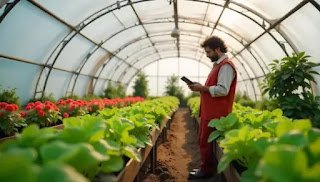Best Greenhouse Designs for Sustainable Farming
As climate change intensifies and resource scarcity grows, sustainable greenhouse farming has emerged as a critical solution. By 2025, the global smart greenhouse market is projected to reach $3.3 billion, driven by innovations in energy efficiency and automation (Grand View Research). This guide explores the 10 best greenhouse designs for sustainable farming, offering actionable insights to help farmers reduce costs, conserve resources, and thrive in a changing climate.
-
Resource Efficiency: Greenhouses use 40-60% less water than open-field farming (FAO).
-
Year-Round Production: Extend growing seasons in extreme climates.
-
Profit Margins: Sustainable designs cut energy costs by up to 70% (USDA).
Top 10 Sustainable Greenhouse Designs for 2025
1. Geodesic Dome Greenhouse
Best For: Harsh climates (snow, high winds)
Features:
-
Triangular panels distribute weight evenly, resisting collapse.
-
Energy Efficiency: 30% less heating required vs. traditional designs.
Case Study: Growing Spaces in Colorado grows tropical fruit year-round in -20°F winters.
2. Solar-Powered Smart Greenhouse
Best For: Off-grid farming
Features:
-
Integrated photovoltaic panels power lighting, heating, and irrigation.
-
AI Sensors: Adjust temperature/humidity autonomously.
Savings: Sundrop Farms in Australia reduced energy costs by 90%.
3. Aquaponic Greenhouse
Best For: Urban or water-scarce regions
Features:
-
Combines fish farming (aquaculture) with hydroponics.
-
Closed-Loop System: Fish waste fertilizes plants; plants filter water.
Yield: Produces 10x more food per sq. ft. (University of Virgin Islands).
4. Walipini (Earth-Sheltered Greenhouse)
Best For: Cold climates
Features:
-
Built 6-8 ft underground, using earth as insulation.
-
Cost: 2,000−5,000 (vs. $10,000+ for glass greenhouses).
Example: Bolivian farmers grow citrus in sub-zero temperatures.
5. Gothic Arch Greenhouse
Best For: Heavy rainfall/snow regions
Features:
-
Steep-angled roof prevents snow/water buildup.
-
Material: Polycarbonate panels (UV-resistant, unbreakable).
6. Sawtooth Greenhouse
Best For: Natural ventilation
Features:
-
Angled roof vents optimize airflow without electricity.
-
Ideal Crops: Leafy greens, herbs.
7. Shade House
Best For: Desert/tropical climates
Features:
-
30-70% shade cloth reduces heat stress.
-
Cost: As low as $1.50/sq. ft.
8. Modular Container Farm
Best For: Urban farming
Features:
-
Repurposed shipping containers with vertical hydroponics.
-
Space Efficiency: 2 acres of yield in 320 sq. ft. (Freight Farms).
9. Biome-Specific Greenhouse
Best For: Biodiversity preservation
Features:
-
Replicates ecosystems (e.g., rainforest, desert).
-
Example: Eden Project in the UK grows 5,000+ species.
10. Plastic Tunnel Greenhouse (High Tunnel)
Best For: Small-scale/low-budget farms
Features:
-
Polyethylene film with roll-up sides.
-
ROI: 1-2 years (NRCS).
Comparative Analysis: Costs & Benefits
How to Choose the Right Design
1. Assess Your Climate
-
Use the Köppen Climate Classification to match designs to your region.
2. Calculate ROI
-
Factor in grants (e.g., USDA’s EQIP covers 50-75% of high tunnels).
3. Prioritize Materials
-
Polycarbonate: 200x stronger than glass, 50% lighter.
-
Bamboo: Sustainable alternative to steel (traps 70% more CO2).
Innovations Shaping 2025 Greenhouses
-
AI-Powered Climate Control: Tools like Motorleaf predict yield losses.
-
Hempcrete Insulation: Carbon-negative material with 3x better insulation than fiberglass.
-
3D-Printed Greenhouses: Modular units printed in 48 hours (Agritecture).
FAQs
Q1: What’s the cheapest sustainable greenhouse?
A: High tunnels (1.50−
1.50−3/sq. ft) or Walipini ($5/sq. ft).
Q2: Can greenhouses work in tropical climates?
A: Yes! Use shade houses or evaporative cooling systems.
Q3: How to heat a greenhouse sustainably?
A: Compost heating (140°F for 6-12 months) or solar thermal panels.
Q4: Are greenhouses profitable?
A: Yes—leafy greens yield 20−20−30/sq. ft annually (Cornell CALS).
Q5: Best crops for small greenhouses?
A: Microgreens, herbs, strawberries, and medicinal plants (e.g., lavender).

.webp)